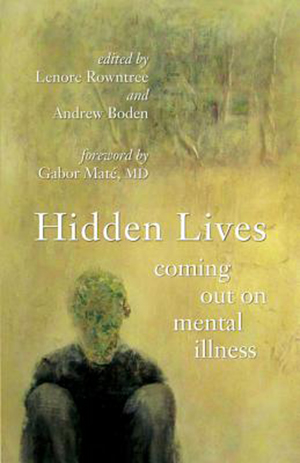Hidden Lives: Coming Out on Mental Illness,
Edited by Leonore Rowntree and Andrew Boden
Published by Brindle and Glass, 264 pages, $24.95
Reviewed by Arleen Pare
The well-known Dr. Gabor Maté writes the book’s foreword. He also writes a back cover blurb which describes Hidden Lives as “(a) privileged if uncomfortable close look at one of the most devastating of human tribulations. For all the honesty of its revelations, Hidden Lives communicates not despair but courage.” These key words, privileged, tribulations, and courage pretty much sum up the reader’s experience. I was keenly aware of the privilege I was being afforded, each page allowing me to regard the details, the emotional pain that mental illness brings to otherwise everyday lives. The tribulations are sorrowful. The courage shines through.
Because I spent two decades working in mental health offices, and because my niece has a serious mental illness, I am personally and professionally familiar with many issues described. Nevertheless, I was riveted. Every story gripped me; I had to keep reading. Each story surprised me with unexpected detail. In “Elm,” Shane Neilson writes “Well, once I wrote poetry. I fell ill. The poetry was in some way intrinsic to the illness. And now I don’t write poetry.” This is an association and a loss I could not have anticipated. Nor could I have expected, in the opening story, “Bad Day,” Joel Yanofsky’s hopelessness about his young son’s future to be so complete that he would welcome the world’s end after reading about an asteroid’s trajectory toward Earth. These are intimate illustrations of the effects of mental illness, the sadness of this human tribulation.
Each story/essay is different not only in terms of point of view (many are written by family members), writerly skill, and proximity to the experience, but also in terms of diagnostic type, intensity of illness, and range of symptoms. Symptoms vary, including threats to others, suicide, or inability to care for self. The results, though sometimes temporary, are often devastating for the individuals with mental illness and for the families who live with and care for and about them.
The order is interesting too. Sometimes a raw piece of writing is juxtaposed against a piece of polished, perhaps professional, writing. At first I thought this structure would be jarring, but in fact, the variety and arrangement worked. Hidden Lives is less about the quality of writing, than the impact of the telling. Even when the writing is raw, maybe especially when the writing is raw, we understand the courage it has taken to put that story on paper. I suspect if all the stories had been polished, the book’s impact might not have been so profound. And it was profound.
After I finished the book, I suggested that my sister, whose daughter has mental illness, might want to read it. She loved it. The sense of support, of not-being-the-only-one-going-through-this-on-her-own, was gratifying. She understood the privilege, and the courage. She understands the hiddenness of mental illness, and she now feels the need to hide a little bit less. Each writer has hidden a little bit less by writing his or her story. This is their courage. Each reader will understand in their own way, and will learn from this book.
Arleen Pare’s most recent book is Leaving Now, published by Caitlin Press
